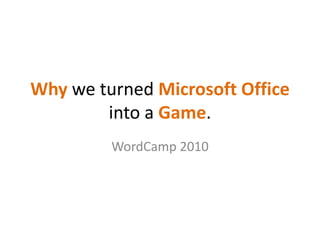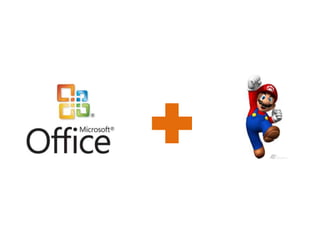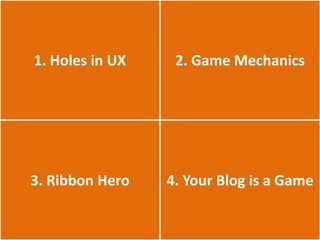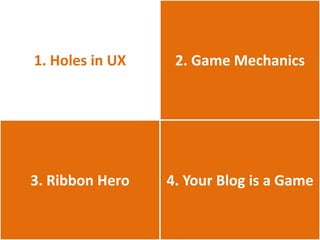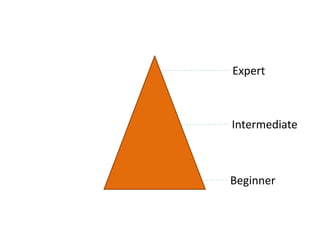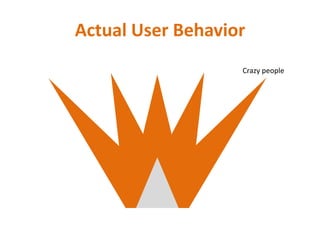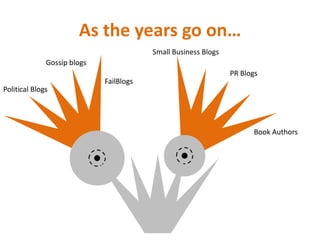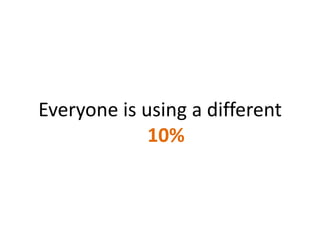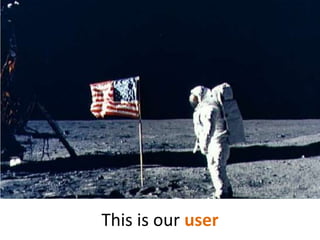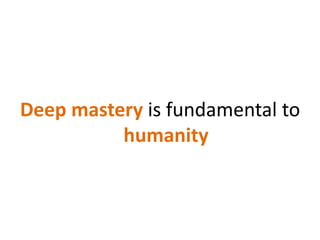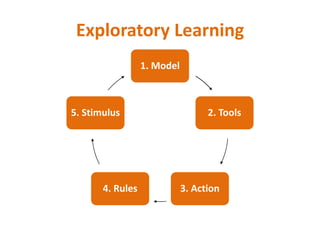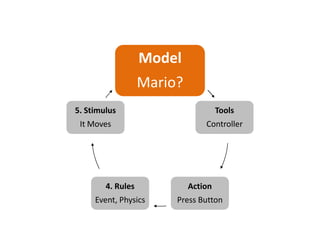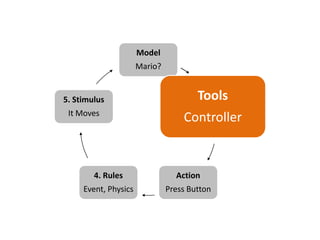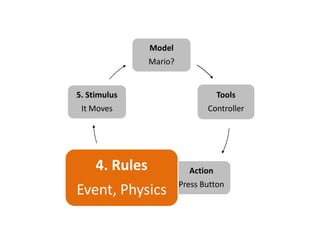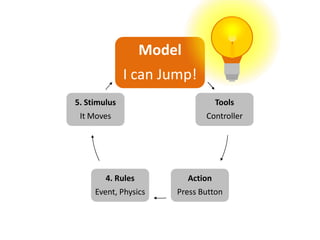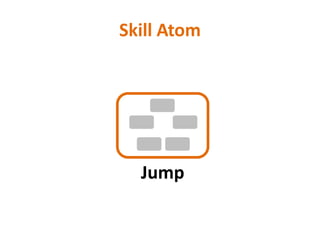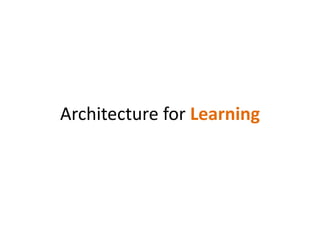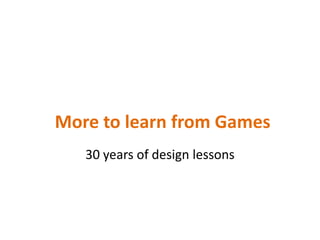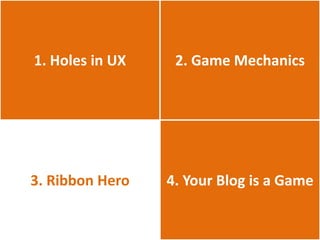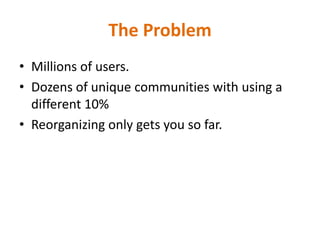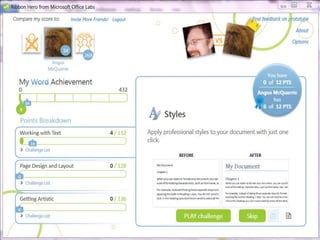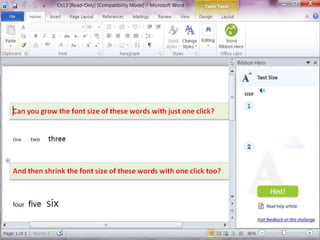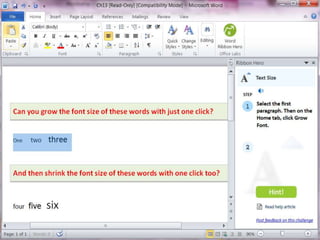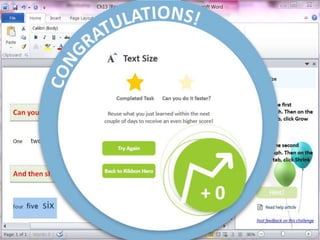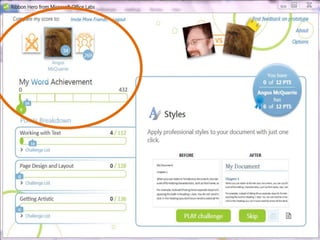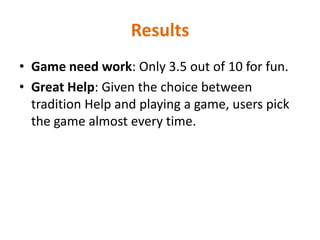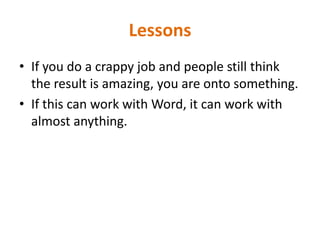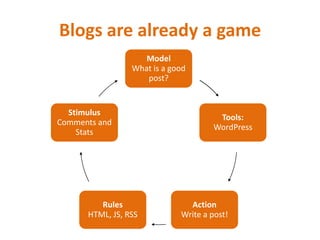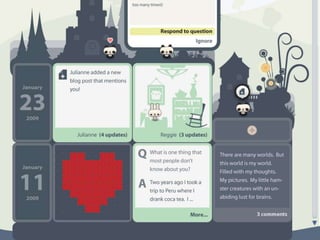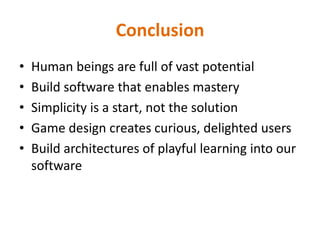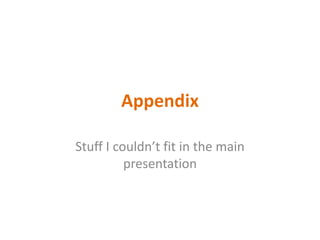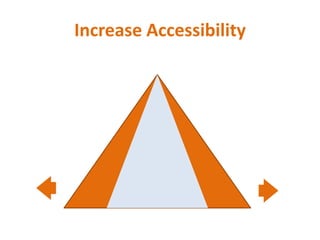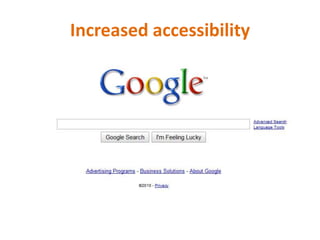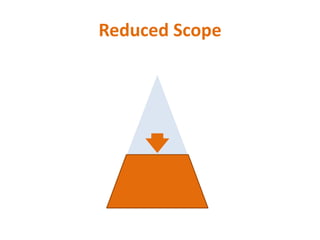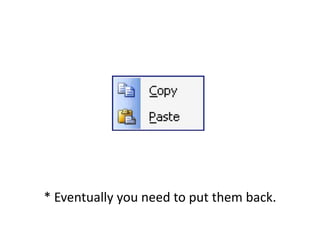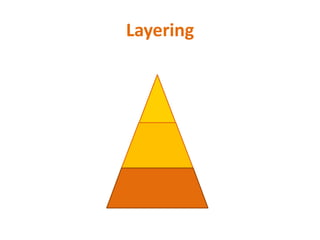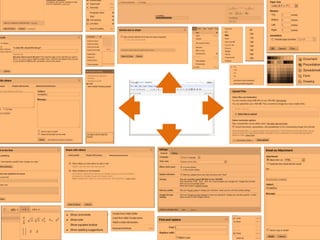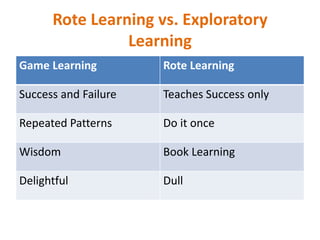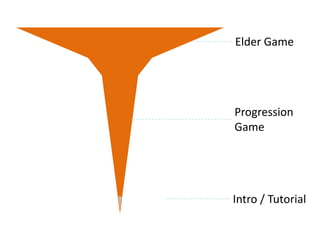Wordcamp 2010: Why we turned Office into a Game
- 1. Whywe turned Microsoft Officeinto a Game.WordCamp 2010
- 7. Lesson: Users hateand fear complexity
- 9. Actual User BehaviorCrazy people
- 10. Cultural ExplosionsNews blogsCorporate blogging
- 11. As the years go onŌĆ”Small Business BlogsGossip blogsPR BlogsFailBlogsPolitical BlogsBook Authors
- 13. Everyone is using a different 10%
- 15. iRock
- 17. This is notour user
- 18. This is our user
- 19. Deep mastery is fundamental to humanity
- 20. How do we build deep tools that unleash immense human potential?
- 22. Games turn learninginto delight
- 30. Skill AtomJump
- 31. Skill TreeKill TurtleMoving PlatformKill Goomba!Collect MushroomJump on PlatformJump
- 33. More to learn from Games30 years of design lessons
- 35. The ProblemMillions of users. Dozens of unique communities with using a different 10%Reorganizing only gets you so far.
- 42. ResultsGame need work: Only 3.5 out of 10 for fun. Great Help: Given the choice between tradition Help and playing a game, users pick the game almost every time.
- 43. LessonsIf you do a crappy job and people still think the result is amazing, you are onto something.If this can work with Word, it can work with almost anything.
- 45. Blogs are already a game
- 47. ConclusionHuman beings are full of vast potentialBuild software that enables masterySimplicity is a start, not the solutionGame design creates curious, delighted usersBuild architectures of playful learning into our software
- 49. AppendixStuff I couldnŌĆÖt fit in the main presentation
- 50. Meaningful Software LastsTyrian (1997)Anark Studio (2000)Microsoft Word (1982)Wordpress (2003)
- 53. Modularity
- 55. Reduced Scope
- 56. * Eventually you need to put them back.
- 57. Layering
- 60. Rote Learning vs. Exploratory Learning
- 61. Elder GameProgression GameIntro / Tutorial
Editor's Notes
- #3: Does anyone here use Microsoft Office? It is used by hundreds of millions of people to create billions of documents across thousands of different communities. What happens when you combine Microsoft Office, one of the oldest and most complex works of consumer software with games? This is exactly the question that Office Labs asked. Office Labs is the wild side of the Office developer organization.
- #4: What we came up with is something called Ribbon Hero, a plugin for Word, Excel and Powerpoint that is turns the act of learning the various features of Office into a social game that can be played during your coffee break. IŌĆÖll dig into Ribbon Hero in more depth later in the talk, but first I wanted to cover a more important issue. Why did we do this? What did we mix the chocolate of games with the peanut butter of everyday applications?
- #5: HereŌĆÖs what IŌĆÖll be talking about today. First, weŌĆÖll cover Holes in modern application and user experience design. The tools we have for designing software are good, but they are missing a major aspect of how users actually use products. Next, IŌĆÖll give you a brief overview of the vast and exciting field of game design and how it offers unique techniques for filling the holes in application design. Then weŌĆÖll take a quick look at Ribbon Hero, an example of how game mechanics improve applications. Finally, if there is time, I want to show what happens when you design a tradtional application like a blog with game mechanics in mind from the very beginning. What happens if we reimaging blogging as a game?
- #6: I am passionate about improving how we design applications. IŌĆÖve been lucky to work on multiple products that have lasted well over a decade and IŌĆÖve noticed a massive gap in our tools.
- #7: HereŌĆÖs the traditional pipeline / pyramid model of how software and users interact. Lots of new users enter into the software at the bottom of the pyramid. Many become upset or frustrated by the experience or donŌĆÖt find what they are looking for, but a few go on to become intermediate users. Finally a very small number of dedicated users master all the features in the application and turn into experts.
- #8: As designers, we take away an important lesson from all this. Users hate and fear complexity and learning. We see it in our usability studies. We see it in our website metrics. Huge swathes of our customer base leave in the first five minutes of trying a website, blog or application. The cries of a million users calling out at once is hard to ignore. It leaves a mental mark on a designer.
- #9: In response, application design has developed a vast array of incredibly useful techniques for streamlining the user experience. We simplify and combine features so that tasks can be done with less learning or fewer steps. We layer our interfaces so advanced tasks are hidden away in advanced areas of the UI. And then we kill features. We reduce the scope of the application by chopping features that only a small percentage of our audience will ever use. Who would ever really use that we ask.
- #10: The problem is that the pyramid model is a lie. It works for the first five minutes of your application. It works for shallow tools that perform limited tasks. However, as soon as you hit upon a useful and interesting server or application, the model starts breaking down. Given time, people do crazy things with your software. Wordpress is a perfect example of a passionate community of users base that pushes the basic product, a simple daily diary, in directions that youŌĆÖd never expect. Boom! Of they go in this direction. And that direction! So much for the tidy pyramid.
- #11: In the delightful process of crazy people doing crazy things, you start getting cultural explosions. Some of the advanced users seed entirely new markets. The daily diary spawn into news aggregators, photo galleries, book promotion sites and more? Look at book blogs. If you arenŌĆÖt a book author with a blog in this modern day and age, you are crazy. WeŌĆÖve altered even how an ancient artform like books are both created and marketed. What is wonderful about these cultural explosions is that they create the exact opposite of the few expert users that youŌĆÖd expect at the tip of the pyramid. Instead they act as magnets that pull in an entirely new population of users and actually expands your market in radical ways.
- #12: In turn these epicenters of cultural utility spawn their own adventuresome users. Now we have polical blogs, gossip blogs, small business blogs and PR blogs. Think about: Blogs are now one of the simple most important methods of communication for large companies like Google, Microsoft and thousands of others. There are entirely new PR, marketing and community management careers built around the advanced mastery of our basic daily dairy.
- #13: WordPress certainly has witnessed this sort of explosion of tool mastery. There are 9432 plugins last time I checked. Wow. It can be overwhelming. I see all these plugins and I have no idea what to do with all of them. Sure, consultants and the community can help to a certain degree, but the complexity is shocking to many users. As an application designer I have an immediate urge to simplify, layer and organize the functionality so that it is more comprehensible and elegant.
- #14: Here you run into a problem. As you start figuring out what people are using, you get this gut wrenching realization. Everyone is using a different 10%. Each community, each distinct user role has their own favorite features and the overlap between them is minimal. This is a hard problem. Microsoft Office and any richly useful piece of software inevitably suffers from it. Even WordPress with the modular plugin model still has risen to a level of complexity where it relies on an army of expert contractors that tailor assemble the right modules for a fee.
- #15: It occurs to me that perhaps that there is something bigger going on here. Something unique and important about the human condition, about who are as the most advanced tool using creates on this planet. Perhaps the crazy usability problems we get into with successful software is not so much a problem, but an opportunity. This is a rock. It is perhaps the most basic tool around. The human race has grown up with rocks. You likely grew up with them and played with them as a child. If we apply modern usability design to this most basic of tools, what do we get?
- #16: You likely end up with this: Smaller, prettier, whiter. Maybe it is balanced for skipping magically long distances on picturesque lakes. When your focus is solely on trimming, killing, and scoping you end up with a prettier more elegant thing. This is not how humans advance. This is not the only thing we have done with rocks.
- #17: We built the pyramids. We create masonry and architecture. We sheltered generations with vast buildings and cities. We created aquaducts and modern plumbing and smelting and metallurgy and the physical sciences. The basic rock in hands of amazing human beings has been mastered and repurposed a thousand, thousand times. The result is civilization. Not a simplified, reduced, limited iRock.
- #18: Amidst all our usability tests and pipeline analysis and focus on making things pretty we occasionally fall into the trap of thinking of our users as infantile apes. Yes, they are clumsy, but we must never lose sight of the fundamental human fact that we learn.
- #19: This is our user. Homo Sapiens. Capable of putting a man on the moon. Capable of passing universal health care.
- #20: Deep mastery of complex tools is fundamental to what it means to be human. It is in our DNA. It is what sets humans apart and is foundational to our success.
- #21: As application developers, we must ask ourselves the following question: How do we build deep tools that are intentionally designed to unleash the immense human potential that exists within our users? It is not enough to say ŌĆ£we made something useful for the first 2 weeks.ŌĆØ It is not enough to say ŌĆ£1% really understand the toolŌĆØ It is not enough to say ŌĆ£Well, if they want to, theyŌĆÖll figure it outŌĆØIt is our duty as designers to create systems that pull users towards mastery.
- #22: Which is where game mechanics come into play.
- #23: Everyone here has played games. Consider a simple game of playground tag. You chase, you are chased. You laugh, you tease, you form alliances and friendship and enemies. If you think about it, tag teaches you more practical lessons about social dynamics and status relationships than any book ever written. When you played tag, you were learning lessons that youŌĆÖll use for the rest of your life. Games are fundamentally about learning. In every single meaningful game ever played, you learn new skills, you master new abilities. And you have a blast doing it. You have so much fun, that you pay me for the honor of learning. You call what you are doing ŌĆśplayŌĆÖ.
- #24: I call ŌĆśplayŌĆÖ a form of exploratory learning. Most people thinking of ŌĆśrote learningŌĆÖ when they think of the word learning. When my mother learns to use a new program, she researches the correct steps and then she writes them down. Step 1, Step 2, Step 3. And she follows those steps exactly. Any deviation thows her off completely. This is book learningŌĆ”you memorize the success path and that remains the entire extent of your knowledge. Play is a form of ŌĆśexploratory learningŌĆÖ. You try stuff. You see what happens. You experience a spectrum of failure and success. And in the process, you learn. A lightbulb goes off and you realized that out of all the thousands of possibilities, there is a mental model that will help you understand and succeed, again and again and again. This is wisdom. Wisdom comes only from direct experience, from exploring the world in a child-like state of delight and wonder. You fail in a thousand tiny ways, but the failure is safe failure and each pass through the exploratory learning loop lets you improve your mental model until you have groked the skill at hand.
- #25: Has anyone here played Super Mario Brothers? In SMB, you learn how to jump. The whole game is built around this one critical activity and yet there are no tutorials or book learning in the game. You plug in the game and you see a world. What does Mario do? There is only one way to find out.
- #26: You have a controller in your hand. This is your tool.
- #27: Well, you might as well start fiddling with it. You press a button. This is the action that you take to interact with the world.
- #28: The game code takes over. Events fire off. The movement and physics code starts iterating through outcomes. These are the carefully designed, yet hidden rules of the system you are attempting to model in you brain.
- #29: The screen reacts to your button press. Mario rises up in the air and falls back down again.
- #30: At this point, something special happens. It doesnŌĆÖt happen in your application. It doesnŌĆÖt happen in the code or on the screen. A change occurs in the playerŌĆÖs mind. The player goes from fiddling with buttons to realizing in a moment of insight that they can jump. They have control over this little blob of plumber-like pixels. Players may go through this learning loop multiple times. You may fail and press the wrong button. You may need to jump several times before you convince yourself that the system works reliably. Yet, when you hit upon the realization, something brilliant occurs. You smile. A wave of tingling delight washes over you. The science backs this up. When we look at the brain in the process of learning, we see the pleasure centers kick in both in the anticipation of future learning and in the moment of skill acquisition. Playful learning = Fun.
- #31: So that is the basic learning loop at the heart of all games. All this can be bundled up in to what is known as a Skill Atom
- #32: And skill atoms can build upon one another. Once you learn jump, you unlock the ability to learn how to jump up on a platform. You learn how to kill a Goomba. Evil, vile Goombas. From there the designer can provide the opportunity to kill turtles and eventually boss monsters. Each skill atom is placed in the proper content and order to build upon the previous skills. This entire structure ultimately contains dozens upon dozens of skills, arranged in a patern that facilitates player mastery. Take note: This is not merely a set of features that we ŌĆśhopeŌĆÖ users will one day master. Instead, the entire system is designed from the core learning loop of each skill atom all the way up to the large scale structure of the skill tree. Learning is not the feared exception. Learning and mastery is the way you use (and enjoy!) the software.
- #33: Games contain a carefully designed architecture for playful learning. The very bones of the software encourage mastery and the expression of human potential as part of their design. We can learn from this. We can apply it to a broader class of applications.
- #34: ThereŌĆÖs a lot to learn from games. There are 30 years of design lessons and thousands of products on the market. Games have more concrete lessons to teach application designers about learning, feedback, user motivation and social systems than almost other field of study.
- #35: With all these thoughts about skills, mastery and the use of game mechanics to unleash human potential, lets look at Microsoft Office.
- #36: Microsoft Word was created in the 1980s and has been growing ever since. It is a perfect case study of a product with immense and fragmented user needs. Comes by these problems honestlyŌĆ”there are probably more creative works built in Microsoft Office than any other set of tools in the history. Certainly Office has tried to reorganize and trim the functionality of Word. The current Ribbon UI at the top of the screen that was introduced in Word 2007 is the latest attempt. But it remains a hard problem: Hundreds of millions of people all using a different 10% of your app.
- #37: So the talented folks in Office Labs came up with a plugin that turns Office in to a game. The goal was to use game mechanics to pull users into the game. We were using the psychology of exploratory learning where players are excited and delighted to discover new skill through play. When you get into Office, youŌĆÖll notice a new indicator to the right. Ribbon hero is sitting in the background, measuring what you do and giving you points for what you know. This is a key lesson of games: As long as we can measure user performance, we can give them feedback that encourages new behaviors.
- #38: Once you click on your score, you are brought to the challenge screen. Here you have a variety of challenges where you attempt to format documents in a minimum number of steps. For example, here we have a challenge that teaches you to apply a style to unformatted text.
- #39: Now hereŌĆÖs the challenge. We give you a goal and let you know that you can get help if you need it. But unlike typically rote learning, we donŌĆÖt force you to watch a video or tell you the explicit steps that you need to perform. Instead, we have a feedback system. When you click on the right thing, we let you know.
- #41: And when you complete the challenge, we give you strong feedback. There is visceral feedback in the form of balloons and big text. This is literally the most exciting feedback that Office users have ever gotten. ThereŌĆÖs also informative feedback. We let them know what they could do better next time and how they performed. The first excites the player, the second piques their deep need for self improvement and mastery.
- #42: Once they are done a challenge they see that their score has improved. We also tie the score into Facebook so you can anchor your learning activities to a social value structure.
- #43: The game isnŌĆÖt an amazing game, but it is head and shoulders above almost any existing learning system. Players are constantly taking 5 minute breaks during the day to ŌĆślearn officeŌĆÖ. It is a fun, light, meaningful casual game. They tweet about it. They excitedly tell their friends. This does not happen in most productivity tools.
- #44: Two lessons: If you do a crappy job and people still think the result is amazing, you are onto something.If this can work with Word, it can work with almost anything.
- #45: What would it look like if we applied all those thoughts about mechanics and mastery to the design of a blogging?
- #46: Blogging was one of the first applications I looked at when I was examining how games might be applied more broadly. The basic skill of ŌĆśBeing a better bloggerŌĆÖ already has strong measurement, tools and informative feedback on the playerŌĆÖs success and failure. Comments are an amazing form of verbal feedback that has been shown to dramatically increase intrinsic motivation. Stats are a form of informative feedback that help players increase their mastery of the art of blogging. It is a strong foundation, but one that was stumbled upon, not explicitly designed. How do we make use game mechanics to create an architecture for playful learning in the context of a blog?
- #47: HereŌĆÖs a personal project that I call the Diary Game. It is targeted at younger audiences and turns blogging into a social game. You start out on an island at sea. You grow the island up into the sky by adding blocks made out of blog posts. Some blocks are images. Some are little social games. Some give you coins to spend on fancier and more interesting blocks. As your island gets taller and taller, you discover a tale about a lost civilization floating in the sky above you. At first the players is just typing in simple responses and enjoying the cute world. But we are clever designers. There is a system in the background that is slowly feeding them more advanced blocks. Each block has quests and goals that encourage players to master it and use it in interesting ways. A player who has played 20 or 30 hours has mastered more skills than 99% of Word Press users will ever master. Play teaches. Our carefully designed architecture for playful learning lets us take the player on a delightful journey of skill mastery.
- #51: We insist on designing for the short term. There is utility in this, especially if we are part of a new company making a new product. Yet the majority of users spend their lives with software theyŌĆÖve used for years. From a user perspective, it is the long term that matters. Sadly we have little experience designing for the long term.
- #52: Here is one way we try to manipulate the user experience pyramid. If we can get more people into the bottom of the pipeline, weŌĆÖll end up with more users overall.
- #53: Simple UI, Easy entrance
- #54: We can also split up a large app into multiple small apps, each with a shallower learning curve.
- #55: The app store is a classic example of this. Actually any plugin system is an example.
- #56: We can reduce the scope of the app. Just lop off the rarely used features.
- #57: Copy and Paste on mobile is a hard problem that many users donŌĆÖt care about. One design pattern weŌĆÖve seen is that initial versions chop out this feature.
- #58: A candy corn! No, not really. The most common technique is layering. High frequency, basic commands are putt on the surface of the application and lower frequency tools are hidden away in subscreens or menus.
- #59: Consider the ŌĆśsimpleŌĆÖ word processor Google Docs.
- #60: In reality there is an immense amount of complexity here. It is just layered away.
- #62: Games have been inverting the triangle for decades. HereŌĆÖs something called the T-model that is used in MMO. The majority of the first part of the game is a set of exploratory training levels. Then as the player becomes more skilled, they branch out into what is called the ŌĆśElder gameŌĆÖ. Here they have far more freeform ability to explore.

